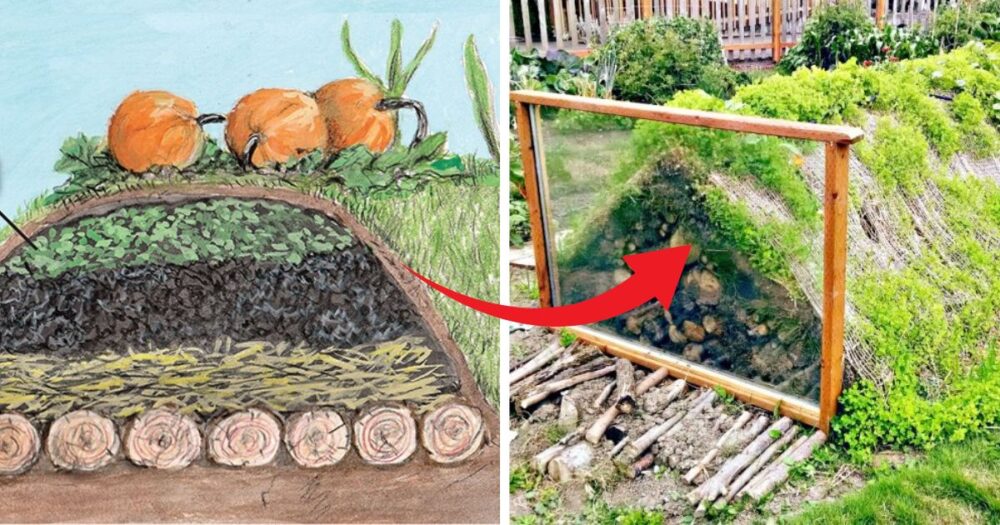Gardening enthusiasts are increasingly drawn to hügel beds for their unique design, which combines composting, water retention, and soil fertility into one elevated structure. For gardeners dealing with limited space or sloped terrain, *steep hügel beds* offer an efficient, resourceful approach to maximizing yield while requiring less maintenance.
In this guide, we’ll delve into the steps of creating a steep hügel bed and explore how it can elevate both your garden’s productivity and sustainability.
What is a Hügel Bed?
A hügel bed, or hügelkultur, is a raised garden bed built on a base of rotting wood and organic material. Originating from traditional German and Eastern European techniques, this method creates rich, moisture-retentive soil that reduces the need for frequent watering and fertilization.
The structure relies on layering organic materials—logs, branches, leaves, compost, and soil—in a mound shape. This layered approach aids in slow nutrient release and fosters a healthy ecosystem for plants.

Why Steep Hügel Beds?
While standard hügel beds are usually mounded at moderate heights, steep hügel beds create a more pronounced slope. These steeper beds provide additional benefits:
Space Efficiency: Steeper slopes allow more growing area in a smaller footprint, ideal for urban or compact gardens.
Enhanced Water Retention: The layered materials act like a sponge, reducing the need for irrigation.
Improved Drainage: Excess water drains quickly from the elevated design, helping to prevent root rot in plants that prefer drier conditions.
Extended Growing Season: Decomposition within the hügel bed generates heat, protecting plants from early frosts and warming the soil for spring planting.
Step-by-Step Guide to Building a Steep Hügel Bed
Building a steep hügel bed requires careful planning and layering. Here’s how to do it step-by-step:
1. Select the Site and Size
Choose a sunny location for your bed. If possible, orient the bed to follow the sun’s path for maximum sunlight. For a steep hügel bed, aim for a height of at least 3–5 feet and adjust the width based on available space. A bed that is too wide may become challenging to reach for weeding and harvesting.
2. Prepare the Base Layer
Start by digging a shallow trench (about 6–12 inches deep) to secure the bed and prevent the base materials from shifting over time. This trench will also create a foundation for the decomposing layers to settle.
Wood Base: Place large logs and thick branches in the trench as the foundation layer. Hardwood like oak or beech is ideal because it decomposes slowly, providing a long-lasting structure.

3. Add Organic Layers
Once the base is secure, start layering materials, ensuring each layer has a balance of “browns” (carbon-rich materials like straw, leaves, and cardboard) and “greens” (nitrogen-rich materials like grass clippings, kitchen scraps, and compost).
- Layer 1 – Logs and Branches: Continue stacking branches over the base logs, forming a central mound.
- Layer 2 – Smaller Branches and Twigs: Fill gaps with smaller branches, creating structure for the steeper slope.
- Layer 3 – Green Materials: Add grass clippings, food scraps, or fresh compost.
- Layer 4 – Leaf Layer: A layer of leaves will improve moisture retention.
- Layer 5 – Soil: Top the mound with a thick layer of soil. This final layer should be nutrient-rich, as it will directly support plant roots.
4. Shape the Slope
To create the steep effect, compact each layer slightly to keep it from slipping and adjust the angle. A slope of 45–60 degrees is ideal for stability and plant growth. Adding stones or logs around the bed’s base can provide additional support for steep beds, preventing erosion and soil runoff.
5. Planting Your Hügel Bed
After constructing the bed, allow it to rest for a week or two before planting. This period helps settle the layers and lets initial decomposition begin.
Choose plants that suit the varied conditions of the hügel bed:
- Top of the Bed: Plants that prefer well-drained soil, like herbs (rosemary, thyme), tomatoes, and beans.
- Middle Slope: vegetables with moderate water needs, such as lettuce, carrots, and cucumbers.
- Base: Water-loving plants like squash, melons, or leafy greens thrive in the moisture-rich lower zones.
6. Maintenance Tips for Steep Hügel Beds
One of the best parts of hügel beds is their low-maintenance nature, but some upkeep is still beneficial:
Mulching: Apply a layer of mulch, such as straw or wood chips, to retain moisture and reduce erosion.
Seasonal Adjustments: Each year, add a small amount of compost or topsoil to maintain fertility as the mound naturally compresses.
Watering: In the first few weeks, water your hügel bed frequently to encourage decomposition. After that, watering needs will reduce as the bed begins to retain moisture.
Benefits of Using Steep Hügel Beds
1. Resource Efficiency
By recycling wood and organic materials, hügel beds promote a zero-waste gardening approach. They reduce the need for fertilizers, mulch, and frequent watering, cutting down on both garden costs and environmental impact.
2. Increased Crop Yield
Thanks to the elevated structure, hügel beds make it easier to grow vertically, maximizing the yield in small spaces. The layered decomposition provides a continuous nutrient supply, promoting healthier, more productive plants.

3. Biodiversity and Soil Health
Decomposing organic materials attract beneficial insects and worms, which improve soil health and help reduce pests. The porous, moisture-retentive layers also create a favorable environment for microbial activity, which enriches the soil over time.
4. Extended Growing Season
The warmth generated by decomposition allows gardeners to plant earlier in the spring and keep plants thriving well into the fall, providing a longer harvest period.
Potential Challenges and Solutions
While steep hügel beds offer many advantages, there are a few challenges to consider:
Soil Erosion: Steep slopes are prone to erosion, particularly during heavy rainfall. To prevent soil loss, use stones or small logs as barriers along the sides of the bed.
Layer Compression: Over time, organic layers will compress, causing the bed to sink slightly. Adding fresh compost annually helps counteract this.
Difficulty with Root Vegetables: In the first year, woody layers may hinder the growth of root vegetables like carrots or beets. Plant these after the initial decomposition stage.
Building a steep hügel bed is an efficient, eco-friendly way to enhance your garden’s productivity and sustainability. By recycling natural materials and reducing the need for synthetic inputs, this method provides a lasting foundation for plant growth.
With proper planning and maintenance, a steep hügel bed can become a resilient, productive centerpiece of any garden—whether on a small urban lot or a sprawling homestead. So why not give it a try and experience the magic of hügelkultur firsthand? Happy gardening!






